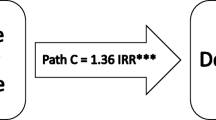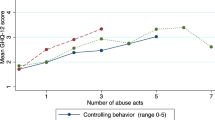Abstract
Using a U.S. nationally representative sample (N = 5,692; U.S. National Comorbidity Survey- Replication Part II [NCS-R]; Alegria et al. 2007), this research explored social support as a possible protective factor for abused women. Women who were physically abused by their partners, but not during the past year reported more positive social support from friends than women who continued to experience physical violence or women who had not experienced partner violence. Women who had experienced recent physical violence reported more negative social support than women who had not experienced partner violence. These findings suggest that positive social support might be a protective mechanism for women in abusive relationships.
Similar content being viewed by others
References
Alegria, M., Jackson, J. S., Kessler, R. C., & Takeuchi, D. (2007). National Comorbidity Survey Replication (NCS-R). In M. Alegria, J. S. Jackson, R. C. Kessler, & D. Takeuchi (Eds.), Collaborative Psychiatric Epidemiology Surveys (CPES), 2001–2003 (ICPSR20240) [Data file]. Ann Arbor: Consortium for Political and Social Research.
Beeble, M., Bybee, D., Sullivan, C., & Adams, A. (2009). Main, mediating, and moderating effects of social support on the well-being of survivors of intimate partner violence across 2 years. Journal of Consulting and Clinical Psychology, 77, 718–729. doi:10.1037/a0016140.
Black, M., Basile, K., Breiding, M., Smith, S., Walters, M., Merrick, M., et al. (2011). The National Intimate Partner Violence and Sexual Violence Survey: 2010 summary review. Retrieved from the Centers for Disease Control website: http://www.cdc.gov/violenceprevention/pdf/nisvs_report2010-a.pdf.
Bosch, K., & Bergen, M. (2006). The influence of supportive and nonsupportive persons in helping rural women in abusive partner relationships become free from abuse. Journal of Family Violence, 21, 311–320. doi:10.1007/s10896-006-9027-1.
Brummett, B., Barefoot, J., Vitaliano, P., & Siegler, I. (2003). Associations among social supports, income, and depression in an educated sample: the UNC alumni heart study. International Journal of Behavioral Medicine, 10, 239–250. Retrieved from http://www.springer.com/medicine/journal/12529.
Carlson, B., McNutt, L., Choi, D., & Rose, I. (2002). Intimate partner abuse and mental health. Violence Against Women, 8, 720–745. doi:10.1177/10778010222183251.
Cohen, S., & Wills, T. (1985). Stress, social support and the buffering hypothesis. Psychological Bulletin, 98, 310–357. doi:10.1037/0033-2909.98.2.310.
Coker, A., Watkins, K., Smith, P., & Brandt, H. (2003). Social supports reduce the impact of partner violence on health: application of structural equation modeling. Preventive Medicine, 37, 259–267. doi:10.1016/S0091-7435(03)00122-1.
Durden, E., Hill, T., & Angel, R. (2007). Social demands, social supports, and psychological distress among low-income women. Journal of Social and Personal Relationships, 24, 343–361. doi:10.1177/0265407507077226.
Folkman, S., & Moskowitz, J. (2000). Positive affect and the other side of coping. American Psychologist, 55, 647–654. doi:10.1037/0003-066X.55.6.647.
Fortin, I., Guay, S., Lavoie, V., Boisvert, J., & Beaudry, M. (2012). Intimate partner violence and psychological distress among young couples: analysis of the moderating effect of social support. Journal of Family Violence, 27, 63–73. doi:10.1007/s10896-011-9402-4.
Goodkind, J., Gillum, T., Bybee, D., & Sullivan, C. (2003). The impact of family and friends’ reactions on the well-being of women with abusive partners. Violence Against Women, 9, 347–373. doi:10.1177/1077801202250083.
Goodman, L., Dutton, M., Vankos, N., & Weinfurt, K. (2005). Women’s resources and use of strategies as risk and protective factors for reabuse over time. Violence Against Women, 11, 311–336. doi:10.1177/1077801204273297.
Haber, M., Cohen, J., Lucas, T., & Baltes, B. (2007). The relationship between self-reported received and perceived social support: a meta-analytic review. American Journal of Community Psychology, 39(1), 133–144. doi:10.1007/s10464-007-9100-9.
Hegadoren, K., Lasiuk, G., & Coupland, N. (2006). Posttraumatic stress disorder part III: health effects of interpersonal violence among women. Perspectives in Psychiatric Care, 42(3), 163–174. doi:10.1111/j.1744-6163.2006.00078.x.
Kessler, R., Berglund, P., Chiu, W. T., Demler, O., Heeringa, S., Hiripi, E., et al. (2004). The U.S. National Comordity Survey Replication: design and field procedures. International Journal of Methods in Psychiatric Research, 13(2), 69–74. doi:10.1002/mpr.279.
Mburia-Mwalili, A., Clements-Nolle, K., Lee, W., Shadley, M., & Yang, W. (2010). Intimate partner violence and depression in a population-based sample of women: can social support really help? Journal of Interpersonal Violence, 25, 2558–2578. doi:10.1177/0886260509354879.
Research Triangle Institute. (2008). SUDAAN Software for the statistical analysis of correlated data (Release 10.0) [Computer software]. Research Triangle Park, NC: Author.
Reynaldo, J., & Santos, A. (1999). Cronbach’s alpha: a tool for assessing the reliability of scales. Journal of Extension, 37(2), 1–6. Retrieved from http://www.joe.org/.
Sarason, I., & Sarason, B. (2009). Social support: mapping the construct. Journal of Social and Personal Relationships, 26, 113–120. doi:10.1177/0265407509105526.
Short, L., McMahon, P., Chervin, D., Shelley, G., Lezin, N., Sloop, K., et al. (2002). Survivor’s identification of protective factors and early warning signs of intimate partner violence. Violence Against Women, 6, 272–285. doi:10.1177/10778010022181840.
Stith, S., Rosen, K., & McCollum, E. (2002). Developing a manualized couples treatment for domestic violence: overcoming challenges. Journal of Marital and Family Therapy, 28(1), 21–25. doi:10.1111/j.1752-0606.2002.tb01168.x.
Straus, M. (1979). Measuring intrafamily conflict and violence: the Conflict Tactics (CT) scales. Journal of Marriage and Family, 41(1), 75–88. Retrieved from http://www.ncfr.org/jmf.
Sullivan, C., & Bybee, D. (1999). Reducing violence using community-based advocacy for women with abusive partners. Journal of Consulting and Clinical Psychology, 67, 43–53. Retrieved from http://www.apa.org/pubs/journals/ccp/index.aspx.
Tjaden, P., & Thoennes, N. (2000). Full report of the prevalence, incidence, and consequences of violence against women: Findings from the National Violence Against Women Survey (Report No. 183781). Washington, DC: National Institute of Justice and the Centers for Disease Control and Prevention.
Vangelisti, A. (2009). Challenges in conceptualizing social support. Journal of Social and Personal Relationships, 26, 39–51. doi:10.1177/0265407509105520.
Vaux, A. (1990). An ecological approach to understanding and facilitating social supports. Journal of Social and Personal Relationships, 7, 507–518. doi:10.1177/0265407590074007.
Walen, H., & Lachman, M. (2000). Social support and strain from partner, family, and friends: costs and benefits for men and women in adulthood. Journal of Social and Personal Relationships, 17, 5–30. doi:10.1177/0265407500171001.
Zlotnick, C., Kohn, R., Keitner, G., & Grotta, S. (2000). The relationship between quality of interpersonal relationships and major depressive disorder: findings from the National Comorbidity Survey. Journal of Affective Disorders, 59, 205–215. doi:10.1016/S0165-0327(99)00153-6.
Zwick, W., & Velicer, W. (1986). Comparison of five rules for determining the number of components to retain. Psychological Bulletin, 99, 432–442. doi:10.1037/0033-2909.99.3.432.
Author information
Authors and Affiliations
Corresponding author
Rights and permissions
About this article
Cite this article
Fleet, C., Hiebert-Murphy, D. Social Support Related to Women Who Have Remained with Their Partners After the Physical Violence has Ceased. J Fam Viol 28, 219–224 (2013). https://doi.org/10.1007/s10896-013-9497-x
Published:
Issue Date:
DOI: https://doi.org/10.1007/s10896-013-9497-x




